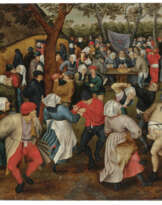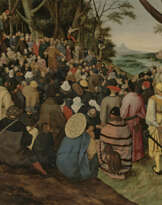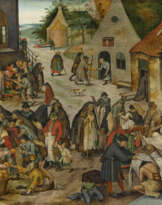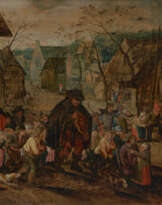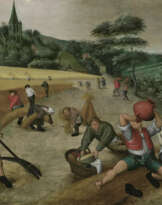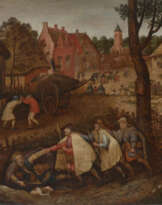ID 1437173
Lot 11 | PIETER BRUEGHEL LE JEUNE (BRUXELLES 1564-1638 ANVERS)
Estimate value
€ 400 000 – 600 000
Le Paiement de la dîme
signé 'P. BREVGHEL.' (en bas, à gauche)
avec la marque de la ville d'Anvers (au revers du panneau)
huile sur panneau
57 x 87,5 cm (22 7/16 x 34 7/16 in.)
Provenance
Acquis par les parents des actuels propriétaires ;
Puis par descendance dans la famille, Espagne.
Further details
PIETER BRUEGHEL THE YOUNGER (1564-1638), THE PAYMENT OF THE TITHES, OIL ON PANEL, SIGNED (LOWER LEFT), WITH THE MARK OF THE CITY OF ANTWERP (TO THE REVERSE)
Patiently waiting their turn, villagers line up in an office where bundles of documents betray its administrative function. They have come to pay their tithe, a contribution paid to the civil or religious institution in kind; here this takes the form of a basket of fresh eggs, grapes or poultry, though money would perhaps have been more welcome!
This unpublished painting is emblematic of the work of Pieter Brueghel the Younger (1564-1636), who in this composition frees himself from the visual legacy of his father, Pieter Bruegel the Elder (c.1525/1530-1569), and of the contemporaries who painted in his wake, such as Marten van Cleve (1527-1581). The Payment of Tithes differs markedly from the usual Breugelian register, whose round, benign faces are so characteristic. The genesis of this work has been the subject of much debate: one theory is that the lost prototype may have been French. Indeed, the presence of an almanac on the right-hand wall, on which the months of the year are written in French, would indicate that the scene takes place in the Kingdom of France, a hypothesis supported by the figures' costumes, which bear no resemblance to the fashions of the former Netherlands. According to the late Klaus Ertz, specialist on the artist, the original prototype may have been a lost painting by the French painter Nicolas Baullery (1560-1630), active in Paris (K. Ertz, Pieter Brueghel der Jüngere (1564-1637/38). Die Gemälde mit Kritischem Oeuvrekatalog, Lingen, 1988/2000, I, p. 496).
This composition can be divided into two sub-categories, each of which is based on the type of wall covering - straw or fabric - depicted below the latticed window. The present painting belongs to the second category: a piece of cloth is stretched over the wall. A further difference between the two groups can be seen in the man standing at far left, who wears a grey-blue shirt in those paintings that show the straw wall covering, which becomes red in the works in the second category. A look at the dated versions of the paintings in these two categories shows that those in the first group are not dated after 1617, while those in the second category are mostly dated between 1618 and 1626. The hypothesise is therefore that Brueghel decided, for some unknown reason, to change his composition and choice of colours around 1618.
Although our painting is not dated, it is signed. The signature ‘P. BREVGHEL' corroborates the above theory, as it indicates that the present work was painted after 1616, the year after which Brueghel stopped signing ’P. BRVEGHEL' and opted for the altered spelling that appears on the present painting (see K. Ertz, 1988/2000, op. cit., p. 19).
| Artist: | Pieter Bruegel II (1564 - 1638) |
|---|---|
| Applied technique: | Oil on panel |
| Art style: | Old Masters |
| Genre: | Genre art |
| Place of origin: | Belgium, Western Europe, Europe |
| Auction house category: | Paintings, Watercolors, Drawings, Paintings |
| Artist: | Pieter Bruegel II (1564 - 1638) |
|---|---|
| Applied technique: | Oil on panel |
| Art style: | Old Masters |
| Genre: | Genre art |
| Place of origin: | Belgium, Western Europe, Europe |
| Auction house category: | Paintings, Watercolors, Drawings, Paintings |
| Address of auction |
CHRISTIE'S 8 King Street, St. James's SW1Y 6QT London United Kingdom | |
|---|---|---|
| Preview |
| |
| Phone | +44 (0)20 7839 9060 | |
| Buyer Premium | see on Website | |
| Conditions of purchase | Conditions of purchase |






